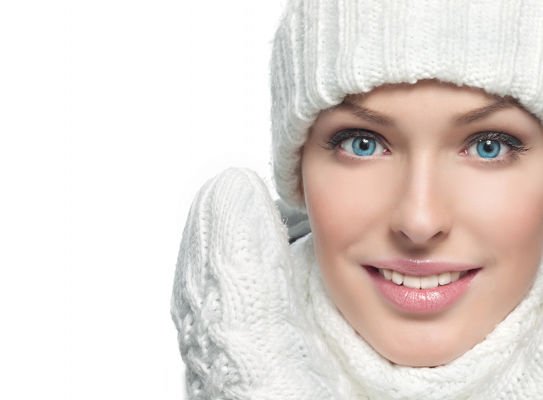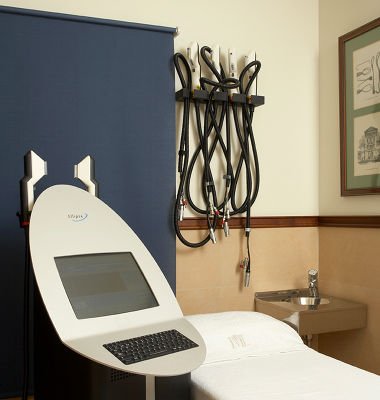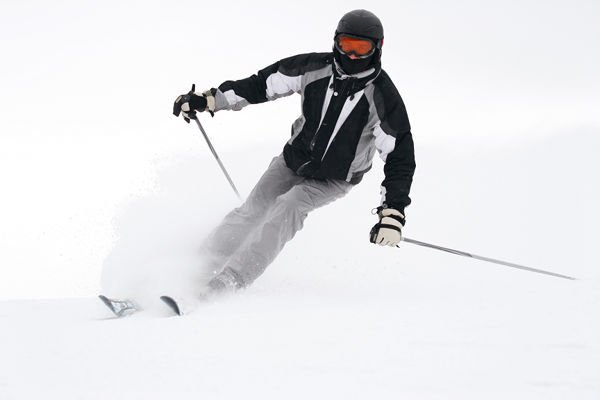Dr María Jose Isarria
Specialist Physician in Dermatology
Dermatology Unit at IML
How does winter affect the skin (cold weather, sudden changes in temperature from warm to cold, the influence of light and pollution, etc…?
Evidently there are climatic factors inherent to winter such as sudden changes in temperature or cold winds that cause adverse effects on the skin.
Skin keeps a memory of all the aggressions it suffers and these winter attacks add to the aggressions of summer. We are all aware of the need to protect our skin during the summer, but in winter the precautions taken diminish.
Sudden temperature changes from warm to cold or vice-versa have a greater impact on males with finer and drier facial skin than those with a larger amount of fat in the skin.
Nevertheless, the skin on any human’s face is not uniform: “We all have different types of skin on our faces; the nose, chin and forehead have an oilier and more moisturized skin. In spite of that, the cheeks and preauricular zones (skin in-front of the ears) is a very fine skin with little hypodermis”. These are the areas that suffer winter damage most and this manifests in drying, premature aging and the appearance of dilated capillaries known as cuperosis.

Sudden changes in temperature or cold winds causes adverse effects on the skin
During winter, hair tends to become dry and lacking in vitality with loss of shine and a slight tendency to falling.
This is caused by the sudden changes in temperature from heated and dry indoors to the winter cold and, on occasion, damp and polluted outdoors. The hair (just as the skin does) dehydrates under these circumstances.
Therefore, hair is dry and brittle and may have more dandruff due to the huge dehydration suffered by the scalp. Breakage of each capillary fibre’s external layers produces a disappearance of the natural shine of healthy hair and creates a brittle, fragile appearance.
The main damage suffered by skin and hair during the summer months is dehydration.
Besides dehydration, skin also shows signs of lesions caused by photo-aging in the form of stains and dilated blood vessels.
A change in the air’s humidity gradient from 90% to 60% equals 30% dehydration of the skin. We can imagine the level of stress suffered by the skin in summer as it adapts itself to the continuous changes from the dryness of room air conditioning to the atmospheric humidity of beaches and swimming pools to the stress of extreme and fast drying that intense exposure to the sun can cause.
This stress continues throughout the winter to the changes in temperature and humidity experienced through changes from dry and warm indoors to cold exteriors. Add to this the even harsher changes in temperature felt with winter mountain activities such skiing.
The first measure we take towards the skin’s recovery from the ravages of summer is to rehydrate. It is vital for the top layer to recover its role as a barrier by helping it to recover its essential structure. We obtain this by applying moisturising substances in the form of creams with a high content in lipids applied daily; these avoid the evaporation of moisture from the skin (hyaluronic acid, vitamin F, squalenes and ceramides).
The next step is to revitalize and repair the damaged skin, for this, and according to the person's condition, IML offers a wide range of medical-cosmetic treatments to revitalize and repair the skin. Based on the Glogau Classification for male and female skins, we should define the treatment choice for each skin type:
Minimal wrinkles, mild pigment changes, multiply dispersed lesions, slight telangiectasias and/or mildly dilated pores.
IPL, Rectangular (Elliptical) Intense Pulsed Light: The new rectangular-pulse Intense Pulsed Light devices allow for a better use of the power emission with maximum therapeutic results in a minimum number of sessions. Cost: approximately €200 per session.

IPL treats minimal wrinkles and mild pigment changes
Expression lines, early to moderate photoaging, early brown spots, keratosis palpable but not visible.
Abundance of wrinkles, advanced photoaging, visible keratosis, discolorations, etc.
Phenol Light or Exoplasty (New to IML*): This treatment is indicated for skin with important accumulated solar damage. Its aim is to completely rejuvenate the epidermis, as well as eliminate all types of stains and photo-induced stigmas. Cost: approximately €2,000.
Wrinkles throughout the face, severe photoaging and yellow-grey skin colour with prior skin malignancies.
Active FX Fractional CO2 Laser. Recommended for treating the skins all over quality, especially skin with pigmented lesions, open pores, wrinkles, laxity, scars, etc. It can be used in two ways:
In relation to the hair, exposure to intense ultraviolet solar radiation during the summer, room air conditioning and sudden temperature changes, chlorine from swimming pools or the salt water and sand at the beach all produce the same drying effects on the hair as the sudden changes in temperature experienced in winter. The hydrolipid layer of the hair follicle wares out and disappears, then the hair splits and scales appear on the cuticular layer.
In order to neutralize the effects on the hair both in winter and in the summer we should consider improving its hydration and nutrition via the application of moisture and nutritional masks and avoid the added stress of intense hot air blow drying that are totally destructive to the keratin surface layer of the hair.
The best nutritional and repairing products for the hair are those that contain polymers that retain water, lecithin to strengthen the hair, olive or sesame oils to moisturize and nourish and shea nut butter to repair.
We keep in mind that hair repair products should be applied according to the person’s individual hair type. Each hair type has its specific treatment:
Very dry hair has a mat appearance, with no shine due to the lack of moisture, conditioners containing olive or almond oil should de used once a week in the form of a nourishing mask. Although, oily hair with a constant excess of grease and a lax and flattened appearance needs the application of substances that combine astringent products that regulate the production of oil.
Nevertheless, if the hair is much deteriorated, shock treatment can be applied with a daily mask over a week.
In winter, the climatic conditions are different to those in summer. Normally, winter sports are carried out in high regions, such as skiing, mountain climbing, etc… In these winter environments, the following factors are decisive:
Winter sports provide constant temperature changes to the hair and skin:
“The skin on the face, hands and neckline suffer constant environmental temperature changes that cause continued dilations and contractions of the dermal capillaries. Skin adapts to cold temperature through intense vasoconstriction of the dermal vessels; but after a few minutes and due to the release of heat through exercise, the skin on the face and other exposed areas starts to perspire where there is dermal vessel vasodilation.
The high level of energy consumption maintains vessels dilated but once the exercise has concluded and the energy level is lower, the vessels contract again. Then when enter a warm environment and due to the need to liberate excess heat due to the heating system, the vessels dilate again."

Winter sports provide constant temperatura changes to the skin
With winter sports, the facial skin suffers vasomotor ups and downs that can easily result in dilated vessels or erythema in the zygomatic area (cheeks) and chin.
The following precautions should be observed:
Once the dilated vessels have appeared on the cheeks, the treatment of choice would be pulsed colour laser, better known as V-Beam laser treatment. This is a specially designed laser used to eliminate the larger vessels and vascular structures on the face and neck. The light in this type of laser is absorbed by the red colour in the vessel.
It is quite usual to obtain full satisfying results in one sole session. At IML we offer our patients’ treatment que includes all the necessary revision sessions to reach optimal results.
This treatment should be carried out under strict supervision of a physician specialised in Dermatology since after treatment the skin requires care that should be set by the specialist.
With winter sports, the hair also suffers from temperature changes but can be avoided by waring head warmers to keep the scalp and hair protected from abrupt temperature changes.
The cheeks and preauricular zones (skin in-front of the ears) have very fine skin with little hypodermis”.
These are the areas that suffer winter damage most and this manifests in drying, premature aging and the appearance of dilated capillaries known as cuperosis or erythema. Therefore, it’s vital to protect the area from solar radiation and control the abrupt changes in dermal circulation with rutoside creams.
Lips are a much hydrated tissue structure and highly exposed in winter sports and in windy climates suffer high levels of dehydration. Specific protection should be applied to the lips. It should be high in oil content to assure that the labial mucous preserves and adequate degree of moisture.
The dermis covering the neck skin, neck line and hands is much finer and also has little hypodermis cover. Early signs of damage are also evident in these regions due to winter aggressions. The best protection for these areas is appropriate warm clothing. And if the skin on these areas is prone to exposure, it should be protected with sunscreens.
Nevertheless, the nose, chin and forehead have oilier and more hydrated skin therefore these areas suffer less during winter sports.
Testosterone is the predominant male sexual hormone.
The action of testosterone on the skin is evident by the stimulation of the sebaceous gland; its activation depends on the secretion of oil that makes up the hydrolipid layer on the skin’s surface responsible for keeping the skin hydrated. This explains that in cases of climatic aggression, men usually have a better level of resistance to skin dehydration than women.
It is also possible that testosterone acts on the base layer of the epidermis and stimulates its divisions.
That is, male skin is basically more resistant than female skin. But this should not mean that men become lax in their skin care routine. Since once the damage is done, the male skin recovers slower and with greater difficulty.
Studies of oestrogen combinations and their effects on the skin allow us to assume that they stimulate the fibroblasts. The result of this is an increased production of elastin and collagen in the female which manifests in improved quality of the skin’s basal elasticity. That is, females have better mechanisms to repair skin damage. Therefore, males must take care of themselves!
Request a free informative consultation. One of our dermatologist will provide you with personalised information of the treatment that best suits your needs.